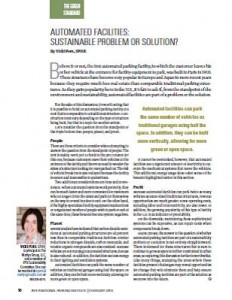Believe it or not, the first automated parking facility, in which the customer leaves his or her vehicle at the entrance for facility equipment to park, was built in Paris in 1905. These structures have become very popular in Europe and Japan in more recent years because they require much less real estate than comparable traditional parking structures. As they gain popularity here in the U.S., it’s fair to ask if, from the standpoint of the environment and sustainability, automated facilities are part of a problem or the solution.
For the sake of this discussion, it’s worth noting that it is possible to build an automated parking facility at a cost that is comparable to a traditional structure. Construction costs vary depending on the type of structure being built, but that is a topic for another article.
Let’s consider the question from the standpoint of the triple bottom line: people, planet, and profit.
People
There are three criteria to consider when attempting to answer the question from the standpoint of people. The first is safety. We’ll put a check in the pro column for this one, because customers leave their vehicles at the entrance of the facility and there’s no need to wander the aisles of a structure looking for one’s parked car. The risk of vehicle break-ins is also reduced because the facility is secure and inaccessible to pedestrians.
Two additional considerations are time and convenience. When automated systems work perfectly, they can be much faster and more convenient for customers who no longer circle the aisles and park for themselves on the way in or wait in a line to exit. On the other hand, if the highly-specialized facility equipment malfunctions or a significant number of people wish to park or exit at the same time, these benefits become system negatives.
Planet
Several studies have indicated that carbon dioxide emissions at automated parking structures are 83 percent less than in comparable traditional facilities. Similar reductions in nitrogen dioxide, carbon monoxide, and volatile organic compounds are also realized. Because vehicles are not running in automated structures, fuel use is also reduced. In addition, the facilities use less energy in their lighting and ventilation systems.
Automated facilities can park the same number of vehicles as traditional garages using half the space. In addition, they can be built more vertically, allowing for more green or open space.
It cannot be overlooked, however, that automated facilities use a significant amount of electricity to operate the mechanical systems that move the vehicles. This additional energy usage does offset some of the benefits highlighted earlier in this section.
Profit
Because automated facilities can park twice as many vehicles as same-sized traditional structures, revenue opportunities are much greater. Some operating costs, including labor and total electricity, are also lower. In addition, the growing popularity of this type of facility in the U.S. is an indicator of profitability.
On the downside, maintaining these sophisticated systems can be expensive, as can repair costs when components break down.
As you can see, the answer to the question of whether automated parking facilities are part of a sustainability problem or a solution is not entirely straightforward. There is demand for these structures that is sure to continue to grow as space is further constrained in urban areas, so exploring this discussion further is worthwhile. Like many things, analyzing the areas where these facilities present challenges may reveal opportunities for change that will eliminate them and help ensure automated parking facilities are part of the solution as we move into the future.
Vicki Pero, SPHR, is principal at The Marlyn Group, LLC, and a member of IPI’s Sustainability Committee. She can be reached at vpero@marlyngroupllc.com or 800.825.6310.
TPP-2014-02-Automated Facilities Sustainable Problem or Solution

